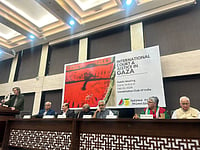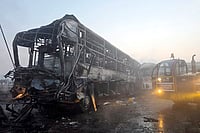“Bloody noisemakers!” Rafik and his brother Mehboob—characters from Simon Lamouret’s graphic novel The Alcazar—would often get cussed at by their neighbours at the construction site where they lived. The last time they played a cricket match, an elderly man had threatened to call the cops, forbidding them to play next to his house. But caught between a life of cement and bricks, the brothers stay on in the hope of being treated better at the cost of extra labour.
“I swear to God, I worked like a madman for months and months but nothing ever changed…nothing,” Mehboob tells Rafik. But suddenly, everything changes for them on the night of March 24, 2020, when Prime Minister Narendra Modi, in a televised announcement, declares a 21-day complete lockdown that makes international headlines. Soon, heart-breaking visuals of migrant workers on the streets hit headlines globally.
When the lockdown struck every corner of the country, Lamouret, a French teacher of design based out of Bengaluru, was sketching vignettes of the lives of migrants. The Alcazar was born out of a construction site around the corner where he lived. In the days that followed, Lamouret saw the crisis from up close. Left alone, with depleting resources on construction sites and almost no access to food and basic needs, many of the workers were desperate to reach home. “No one to seek help from and with almost no money, a few of them even considered paying a smuggler to drive them home,” Lamouret tells Outlook.

Published by Comix India in 2022, the French original, L’Alcazar was translated into English by Prutha Narke. The 212-page graphic novel captures the ‘invisible’ lives of workers spread across fast-paced urban spaces. Lamouret attempts to understand their struggles as they build, from scratch, an upcoming apartment complex called ‘The Alcazar’ on Hutchins Road in Bengaluru. The author himself spent 7 months weaving in and out of the construction site, befriending the workers and skilfully fictionalising their lives onto the pages of The Alcazar.
The Alcazar zeroes in on the undignified conditions of migrant workers’ lives. The main characters of the book all remain real, from their names to the way they look in the drawings. The stories of Salma, Mehboob, Rafik and Basha are at the heart of the graphic novel. The book closely follows the group along with a host of other characters—Raja, Subaan Ali, Trinna, Ganesh, and Samay, whose lives blend seamlessly to give the reader a sense of actually being on the construction site. The bulk of the narrative revolves around the daily affairs of migrant workers—their arrival at the site, their joys, sorrows and struggles impacted by class hierarchy and gender inequality.

“Construction sites don’t have the most basic facilities for those who live on the site. Their homes go from being tents to almost finished rooms (during later stages of construction) and they do heavy lifting that affects their bodies in a few years. And all this for a very low salary,” says Lamouret.He manages to open up a world around us that is at once a part of the everyday yet remains alienated. The windows of the half-constructed Alcazar take the reader into a life carefully composed of skill, migration, and resilience but its very existence is largely overlooked or dismissed. Beneath the blue tarpaulin put up here and there, the graphic novel becomes a depiction of the life trajectories of its unforgettable characters. For Lamouret, the construction site becomes the perfect metaphor to highlight the plight of migrant workers because the word ‘alcazar’ in Arabic means ‘fortress’, a place you cannot enter yet a place you have to exit from, during a siege.

When Lamouret stepped into Bengaluru almost a decade ago to experience and understand the different lives of Indians, he saw the city grow in myriad ways. While his approach to the novel is a tad ‘journalistic,’ he “did not want it to be a narrative of poverty.” The author believes that each and every character that he developed in the book was worth being represented. They had a past, a future and complex ties to the present.
Three years after that announcement on television, The Alcazar is a poignant reminder for Indians to restart the crucial conversation around the precarious lives of migrant workers in chaotic spaces.


























